Search results for 'shipping company database'
-
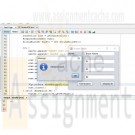
CIS355A Week 6 Lab - Database Connectivity Student Management System
Regular Price: $10.00
Special Price $8.00
CIS355A Week 6 Lab - Database Connectivity Student Management System
OBJECTIVES
• Programmatic access to a MySQL database to add and display records
PROBLEM: Student Management System
A teacher needs the ability to store and retrieve student data. This includes
• student name;
• three test scores;
• average; and
• letter grade.FUNCTIONAL REQUIREMENTS
You can code the GUI by hand or use NetBeans GUI builder interface.
Create a GUI which allows for input and display of student data.
It should include buttons to save a record, display all records.Create a database and table to store student name and three test scores. (Note that average and grade are calculated by app.)
Student class
Create a Student class to manage the student data. It should have private instance variables of
• student name; and
• three test scores.
The class must have the following methods.
• A default and parameterized constructor
• Sets/gets for all instance variables
• A get method to calculate and return the average
• A get method to calculate and return the letter grade
• toString to display the name of the studentStudentDB class
Create a StudentDB class that is used to create a connection and interface with the database.This class should have two methods.
• getAll - reads data from database, returns data in an arraylist of student objects
• add - writes a record to the databaseGUI class
Insert button will take the info from the GUI (student name and three test scores) and insert a record into the table. Input should be cleared from the textboxes.
Display button will read the data from the database and creates a report in Console window, sample format below.
Name Test1 Test2 Test3 Avg Grade
Bruce Wayne 90 95 98 94.3 A
Clark Kent 65 70 90 75.0 CRUBRIC
Student class
• Has all required functionality 10
GUI class
• Student record can be saved
• All student data can be displayed 15
StudentDB class
• add method inserts a record into db.
• get method reads all records and returns in arraylist. 15
Code style 5
Lab Report 10
TOTAL 55CODE STYLE REQUIREMENTS
• Include meaningful comments throughout your code.
• Use meaningful names for variables.
• Code must be properly indented.
• Include a comment header at beginning of each file, example below.
/****************************************************
Program Name: ProgramName.java
Programmer's Name: Student Name
Program Description: Describe here what this program will do
***********************************************************/DELIVERABLES
Submit as a SINGLE zip folder
• all java files; and
• the Lab report.Follow assignment specification regarding class/method names.
Learn More
Note that your Java file name must match class name (DO NOT rename). -
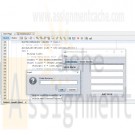
CIS355A Week 5 Lab - File Processing Stocks4U
Regular Price: $10.00
Special Price $8.00
CIS355A Week 5 Lab - File Processing Stocks4U
OBJECTIVES
• Add persistent data storage to your Week 4 Lab using text file input/output.PROBLEM: Stocks4U Portfolio Management System
The portfolio management system you developed for Stocks4U needs the ability to save and restore a user’s data from a text file.FUNCTIONAL REQUIREMENTS
You can code the GUI by hand or use NetBeans GUI Builder Interface.
You will enhance Week 4 GUI to include
• a File menu with menu items: open, save, exit; and
• a label to display total portfolio value.Stock class
• Modify the toString of Stock class to display as
"Company: qty shares" (i.e., "Apple: 10 shares")StockIO class
Create a StockIO class that is used to read from and write to a text file using an ArrayList. Make sure to use a delimiter between the fields; it does not have to be the # character. Example format of the file is:Apple#100#55.0#80.0
Intel#50#75.0#70.0This class should have two methods.
• getData - reads data from file, returns data in array list of stock objects
• saveData - writes data from an array list to the file in proper format
The file name will be an instance variable that you can set with a parameterized constructor, or with a separate method.GUI class
Note that you will need to add an ArrayList to your GUI class to manage the data to/from the file. It will act as a parallel array to your DefaultListModel. Any time you add a stock, you must add it in BOTH places. Any time you remove a stock, you must remove it in BOTH places.File - open should prompt for file name using JOptionPane, read the file and populate the JList.
File - save should prompt for file name to save data from JList to.
File - exit should exit the program.The total value of the portfolio should be displayed at all times and updated anytime a stock is added or removed.
RUBRIC
Stock class toString modified 5
GUI class
• Menu is added.
• Label is added for total portfolio value.
• Open menu item reads data from a file and displays in list box.
• Save menu item writes data to a text file in proper format.
• Total value is updated whenever any changes are made to stocks (add, remove, open a new file). 15
StockIO class
• getData method reads from file to array list
• saveData method writes from array list to file 20
Code style 5
Lab Report 10
TOTAL 55CODE STYLE REQUIREMENTS
• Include meaningful comments throughout your code.
• Use meaningful names for variables.
• Code must be properly indented.
• Include a comment header at beginning of each file, example below.
/****************************************************
Program Name: ProgramName.java
Programmer's Name: Student Name
Program Description: Describe here what this program will do
***********************************************************/DELIVERABLES
Submit as a SINGLE zip folder
• all Java files; and
• the Lab report.Follow assignment specification regarding class/method names.
Learn More
Note that your Java file name must match class name (DO NOT rename). -
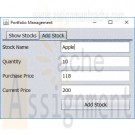
CIS355A Week 4 Lab - Processing Arrays of Objects Stocks4U
Regular Price: $12.00
Special Price $10.00
CIS355A Week 4 Lab - Processing Arrays of Objects Stocks4U
OBJECTIVES
• Create a GUI that uses JList and JTabbedPanes.
• Process multiple objects in an ArrayList.
• Code event handlers for multiple events.PROBLEM: Stocks4U Portfolio Management System
Stocks4U needs to develop an app for you to manage your stock purchases. You should be able to store a list of stock purchases, view the individual stocks, add and remove stocks.FUNCTIONAL REQUIREMENTS
You can code the GUI by hand or use NetBeans GUI builder interface.The GUI should have two tabs using JTabbedPane.
• One tab ("Show stocks") should have
o a JList to display all the stock purchases;
o a text field or label to display information about a particular stock; and
o a JButton to remove a stock.
• One tab ("Add stock") should have textboxes, labels, and a button to input a stock.Create a Stock class to manage the stock activity. It should have private instance variables of
• company name;
• number of shares;
• purchase price; and
• current price.
Create a default and parameterized constructor.
Create sets/gets for all instance variables.
Create a get method to calculate and return the profit or loss. This would be calculated as
Number of shares * (current price – purchase price).
Create toString to display the name of the stock.As you add stocks, they are displayed in the JList.
If you select an element in the JList, the gain or loss is displayed in the label or text field.
If you select an element in the JList and click Remove, the stock is removed from the list.GRADING RUBRIC
Stock class
• Has all required functionality 15
GUI class
• Use the Stock class to process data.
• As you add stocks, they are displayed in the JList.
• If you select an element in the JList, the gain or loss is displayed in the label or text field.
• If you select an element in the JList and click Remove, the stock is removed from the list.
• Use error messages for any invalid/missing user input using JOptionPane. 25
Code style 5
Lab Report 10
TOTAL 55CODE STYLE REQUIREMENTS
• Include meaningful comments throughout your code.
• Use meaningful names for variables.
• Code must be properly indented.
• Include a comment header at beginning of each file, example below.
/****************************************************
Program Name: ProgramName.java
Programmer's Name: Student Name
Program Description: Describe here what this program will do
***********************************************************/DELIVERABLES
Submit as a SINGLE zip folder
• All java files
• Lab reportFollow assignment specification regarding class/method names.
Learn More
Note that your java filename must match class name (DO NOT rename). -
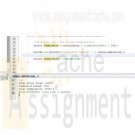
DAT 210 Data Programming Week 3 Calculates the total annual compensation of a salesperson
Regular Price: $12.00
Special Price $10.00
DAT 210 Data Programming Week 3 Calculates the total annual compensation of a salesperson
You work for a software company has just created a new incentive for salespeople to earn a commission on each sale. The current program only allows for a fixed salary. The Chief Information Officer (CIO) has asked you to create a new program that allows the functionality for a fixed salary and commission.
Write a Java application, using NetBeans IDE, that calculates the total annual compensation of a salesperson.
Consider the following:
• A salesperson will earn a fixed salary of $30,000.
• A salesperson will also receive a commission as a sales incentive. Commission is a percentage of the salesperson's annual sales. The current commission is 7% of total sales.
• The total annual compensation is the fixed salary plus the commission earned.The Java® application should meet the following technical requirements:
• The application should have at least one class, in addition to the application's controlling class. (A controlling class is where the main function resides).
• A file needs to be created to contain the output.
• There should be proper documentation in the source code.
• The application should ask the user to enter annual sales, and it should display the total annual compensation.Compile your Java application files into a ZIP folder.
Learn More
Review the Lynda.com videos from this week if you have additional questions on creating a program in Java.
Submit the ZIP file. -

PRG 421 Week 4 Individual Analyze Assignment Analyzing a Multithreaded Program
Regular Price: $7.00
Special Price $5.00
PRG 421 Week 4 Individual Analyze Assignment Analyzing a Multithreaded Program
Deadlock occurs when no processing can occur because two processes that are waiting for each other to finish. For example, imagine that two processes need access to a file or database table row in order to complete, but both processes are attempting to access that resource at the same time. Neither process can complete without the other releasing access to the required resource, so the result is deadlock.
Read and analyze code in the linked document that spawns two different threads at the same time.
In a Microsoft® Word file, predict the results of executing the program, and identify whether a deadlock or starvation event will occur and, if so, at what point in the code.
Submit your Word file to the Assignment Files tab.
1. Predict the results of executing the program.
2. Identify whether a deadlock or starvation event will occur and, if so, at what point in the code./**********************************************************************
* Program: Week 4 Analyze a Multithreaded Program
* Purpose: Review the code and predict the results for the program execution.
* Programmer: Iam A. student
* Instructor: xxx
***********************************************************************/
Package example deadlk;public class Deadlock {
public static Object Lock1 = new Object(); // aacquires lock on the Lock1 object
public static Object Lock2 = new Object(); // aacquires lock on the Lock2 object
public static void main(String args[]) {
ThreadDemo1 T1 = new ThreadDemo1(); // define the new threads
ThreadDemo2 T2 = new ThreadDemo2(); // and set name for the threads
T1.start();
T2.start();
}private static class ThreadDemo1 extends Thread {
public void run() {
synchronized (Lock1) {
// synchronized Lock1 and Lock 2 will hold the thread until release
System.out.println("Thread 1: Holding lock 1...");
try { Thread.sleep(10); } // pause for 10 secs, then access thread
catch (InterruptedException e) {} // if exception happens, “catch it”
System.out.println("Thread 1: Waiting for lock 2..."); // display wait condition
synchronized (Lock2) {
System.out.println("Thread 1: Holding lock 1 & 2...");
}
}
}
}private static class ThreadDemo2 extends Thread {
Learn More
public void run() {
synchronized (Lock2) {
System.out.println("Thread 2: Holding lock 2...");
try { Thread.sleep(10); } // pause for 10 secs, then access thread
catch (InterruptedException e) {} // if exception happens, “catch it”
System.out.println("Thread 2: Waiting for lock 1..."); // display wait condition
synchronized (Lock1) {
System.out.println("Thread 2: Holding lock 1 & 2...");
}
}
}
}
} -

PRG 421 Week 1 Individual Analyze Assignment Analyzing a Java Program Containing Abstract and Derived Classes
Regular Price: $6.00
Special Price $4.00
PRG 421 Week 1 Individual Analyze Assignment Analyzing a Java Program Containing Abstract and Derived Classes
"Analyzing a Java™ Program Containing Abstract and Derived Classes"
The purpose of creating an abstract class is to model an abstract situation.
Example:
You work for a company that has different types of customers: domestic, international, business partners, individuals, and so on. It well may be useful for you to "abstract out" all the information that is common to all of your customers, such as name, customer number, order history, etc., but also keep track of the information that is specific to different classes of customer. For example, you may want to keep track of additional information for international customers so that you can handle exchange rates and customs-related activities, or you may want to keep track of additional tax-, company-, and department-related information for business customers.
Modeling all these customers as one abstract class ("Customer") from which many specialized customer classes derive or inherit ("International Customer," "Business Customer," etc.) will allow you to define all of that information your customers have in common and put it in the "Customer" class, and when you derive your specialized customer classes from the abstract Customer class you will be able to reuse all of those abstract data/methods.This approach reduces the coding you have to do which, in turn, reduces the probability of errors you will make. It also allows you, as a programmer, to reduce the cost of producing and maintaining the program.
In this assignment, you will analyze Java™ code that declares one abstract class and derives three concrete classes from that one abstract class. You will read through the code and predict the output of the program.
Read through the linked Java™ code carefully.
Predict the result of running the Java™ code. Write your prediction into a Microsoft® Word document, focusing specifically on what text you think will appear on the console after running the Java™ code.
In the same Word document, answer the following question:
Why would a programmer choose to define a method in an abstract class, such as the Animal constructor method or the getName() method in the linked code example, as opposed to defining a method as abstract, such as the makeSound() method in the linked example?Supporting Material: Week One Analyze Assignment Text File
/**********************************************************************
* Program: PRG/421 Week 1 Analyze Assignment
* Purpose: Analyze the coding for an abstract class
* and two derived classes, including overriding methods
* Programmer: Iam A. Student
* Class: PRG/421r13, Java Programming II
* Instructor:
* Creation Date: December 13, 2017
*
* Comments:
* Notice that in the abstract Animal class shown here, one method is
* concrete (the one that returns an animal's name) because all animals can
* be presumed to have a name. But one method, makeSound(), is declared as
* abstract, because each concrete animal must define/override the makeSound() method
* for itself--there is no generic sound that all animals make.
**********************************************************************/package mytest;
// Animal is an abstract class because "animal" is conceptual
// for our purposes. We can't declare an instance of the Animal class,
// but we will be able to declare an instance of any concrete class
// that derives from the Animal class.
abstract class Animal {
// All animals have a name, so store that info here in the superclass.
// And make it private so that other programmers have to use the
// getter method to access the name of an animal.private final String animalName;
// One-argument constructor requires a name.
public Animal(String aName) {
animalName = aName;
}// Return the name of the animal when requested to do so via this
// getter method, getName().
public String getName() {
return animalName;
}// Declare the makeSound() method abstract, as we have no way of knowing
// what sound a generic animal would make (in other words, this
// method MUST be defined differently for each type of animal,
// so we will not define it here--we will just declare a placeholder
// method in the animal superclass so that every class that derives from
// this superclass will need to provide an override method
// for makeSound()).
public abstract String makeSound();
};// Create a concrete subclass named "Dog" that inherits from Animal.
// Because Dog is a concrete class, we can instantiate it.
class Dog extends Animal {
// This constructor passes the name of the dog to
// the Animal superclass to deal with.
public Dog(String nameOfDog) {
super(nameOfDog);
}// This method is Dog-specific.
@Override
public String makeSound() {
return ("Woof");
}
}// Create a concrete subclass named "Cat" that inherits from Animal.
// Because Cat is a concrete class, we can instantiate it.
class Cat extends Animal {
// This constructor passes the name of the cat on to the Animal
// superclass to deal with.
public Cat(String nameOfCat) {
super(nameOfCat);
}// This method is Cat-specific.
@Override
public String makeSound() {
return ("Meow");
}
}class Bird extends Animal {
// This constructor passes the name of the bird on to the Animal
// superclass to deal with.
public Bird (String nameOfBird) {
super(nameOfBird);
}// This method is Bird-specific.
@Override
public String makeSound() {
return ("Squawk");
}
}public class MyTest {
Learn More
public static void main(String[] args) {
// Create an instance of the Dog class, passing it the name "Spot."
// The variable aDog that we create is of type Animal.
Animal aDog = new Dog("Spot");
// Create an instance of the Cat class, passing it the name "Fluffy."
// The variable aCat that we create is of type Animal.
Animal aCat = new Cat("Fluffy");
// Create an instance of (instantiate) the Bird class.
Animal aBird = new Bird("Tweety");
//Exercise two different methods of the aDog instance:
// 1) getName() (which was defined in the abstract Animal class)
// 2) makeSound() (which was defined in the concrete Dog class)
System.out.println("The dog named " + aDog.getName() + " will make this sound: " + aDog.makeSound());
//Exercise two different methods of the aCat instance:
// 1) getName() (which was defined in the abstract Animal class)
// 2) makeSound() (which was defined in the concrete Cat class)
System.out.println("The cat named " + aCat.getName() + " will make this sound: " + aCat.makeSound());
System.out.println("The bird named " + aBird.getName() + " will make this sound: " + aBird.makeSound());
}
} -
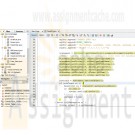
CIS355A Week 6 Practice Program - Pizza Data/IO
Regular Price: $12.00
Special Price $10.00
CIS355A Week 6 Practice Program - Pizza Data/IO
Introduction - Connecting and Manipulating Databases
This week you’re going to replace the File IO operations your completed last week and replace them with database operations. During this exercise you will see the advantage of making the effort in creating a 3-tiered architecture that encapsulations the operations into the appropriate layer.
Use your OmnyBus MySQL Account
Updating the Pizza Order Program:
Here is what you will need to do to get the Pizza Program to work.
In the OmnyBus EDUPE server management application:
Open the database you created.
Create a table called "PizzaOrder" with the following fields
1) id as an Int, set to primary key, set Autoincrement = yes
2) firstName as a varchar of length 50
3) lastName as a varchar of length 50
4) size of type small int
5) cheese as a tinyint (MySQL boolean)
6) sausage as tinyint
7) ham as a tinyint
8) total as a double
In the Netbeans (or Eclipse) project ensure that the MYSQL jar file is correctly referenced (in your assignments, you will have to move this file into your project and set the path to the jar file):
Right click on the project name, then select "Properities".
Select libaries
Confirm that the mysql-connector.jar file is listed in the "Compile Time Libaries:"
See the following that demonstrates how to set the driver, jar reference path:In the Data project, DataIO class update the following constant fields to showy our credential information:
Learn More
CONNECTION_STRING
USER_NAME
PASSWORD
In the DataIO class there are TODO items (select WINDOW|ACTION ITEM to see list of todo, click to take you to the code location). You are then asked to modify the following methods to interact with the database.
add method
delete method
update method
getList method -
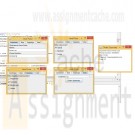
CIS355A Week 6 iLab Swing and Database Connection
Regular Price: $25.00
Special Price $20.00
CIS355A Week 6 iLab Swing and Database Connection
Learn More
iLAB OVERVIEW
Scenario/Summary
Develop one application using JTabbedPanes and JFrames and another application that connects to a MySQL database.
Deliverables
1. JavaPizza
2. ContactList
iLAB STEPS
Step 1: JavaPizza
Develop an application using a JTabbedPane to order a pizza. You will need to ask the customer for their name and phone number. You will ask for the size (choose one) and toppings (choose many) and compute the total. After computing the total, provide a button to display the order summary, which includes the name, phone number, size, toppings, and total. The prices are listed below. Screenshots of a possible solution are included. Your application must include four tabs and open a new window when the button is clicked.
• Small: 8.00
• Medium: 10.00
• Large: 12.00
Each topping is 2.00 extra.
JavaPizza Points Description
Standard header included 1 Must contain program's name, student name, and description of the program
Program compiles 1 Program does not have any error
Program executes 1 Program runs without any error
Created the JTabbedPane with four tabs 4 The JTabbedPane is displayed with the four required tabs and components on each tab
Total is calculated correctly 5 The total on the last tab is calculated correctly based on information supplied.
Order summary window displayed correctly 8 The order summary window is displayed with a JTextArea, including all information from the four tabs.
Subtotal 20
Step 2: Contact List
Develop a Java application to add a contact into the contact table, and display all contacts in the contact table. The contact table contains two columns, FullName, and PhoneNumber. Both values are text data. Use JOptionPanes to ask for the contact data, and display a confirmation message when the contact is added. Display the list of contacts in the console. Screenshots of a possible solution are included.
ContactList Points Description
Standard header included 1 Must contain program's name, student name, and description of the program
Program compiles 1 Program does not have any error
Program executes 1 Program runs without any error
Created the JOptionPanes for input 6 Two JOptionPanes are displayed to retrieve input
JOptionPane displayed upon insert 4 A JOptionPane is display to confirm the contact was added
ContactList shown in console 7 The list of contacts is displayed in the console under a heading contact list .
Subtotal 20 -
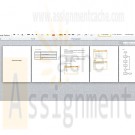
CIS355A Week 4 Course Project Flooring Application Analysis and Design
Regular Price: $20.00
Special Price $15.00
CIS355A Week 4 Course Project Flooring Application Analysis and Design
Developing a graphical user interface in programming is paramount to being successful in the business industry. This project incorporates GUI techniques with other tools that you have learned about in this class.
Here is your assignment: You work for a flooring company. They have asked you to be a part of their team because they need a computer programmer, analyst, and designer to aid them in tracking customer orders. Your skills will be needed in creating a GUI program that calculates the flooring cost and stores the order in the database.
The project has three components: an analysis and design document, the project code, and a user manual. The analysis and design document is due Week 4. The code and user manual are due in Week 7. It is suggested that you begin working on the code in Week 5, which should give you ample time to complete the project. You will find that the lectures and lab assignments will prepare you for the Course Project.Guidelines
Your application must include at least three tabs. The user will choose wood flooring or carpet, enter the length and width of the floor, as well as the customer name and address. The application will compute the area of the floor and the cost of the flooring considering that wood floor is $20 per square foot and carpet is $10 per square foot. A summary should be displayed, either in a tab or another window, listing the customer name and address, floor selection, area, and cost. This information should also be stored in the MySQL database table. The program should validate that all information is entered and that the length and width are numeric values. Any numeric or currency values must be formatted appropriately when output. Recommendations for the components used for input are
• radio buttons—flooring type (wood or carpet);
• text fields—customer name, customer address, floor length, and floor width; and
• buttons—calculate area, calculate cost, submit order, display order summary, display order list.
The MySQL database table is called flooring and has the following description.
Field Type
CustomerName varchar(30)
CustomerAddress varchar(50)
FlooringType varchar(10)
FloorArea Double
FloorCost Double
In addition to entering new customer orders, your application should list all customer orders stored in the database. These will be viewed as a list, in a text area, and will not be updated by the user.Analysis and Design (Due Week 4)
Learn More
In Week 4, you will complete the analysis and design for the project. You will use the guidelines described above and the grading rubric below to complete this document. You will create the following items.
1. Request for new application
2. Problem analysis
3. List and description of the requirements
4. Interface storyboard or drawing
5. Design flowchart or pseudocode
The analysis and design document will be a single MS Word document, which contains all descriptions and drawings. See the grading rubric below for the analysis and design document, due in Week 4.
Item Points Description
Request for New Application 2.5 A table containing: date of the request, name of the requester (your professor), the purpose of the request, the title of the application (create your own title), and brief description of the algorithms used in the application
Problem Analysis 2.5 Analyze the problem to be solved, and write in a few words what is the problem and what is being proposed to solve the problem
List and Description of Requirements 5 A description of the items that will be implemented in order to construct the proposed solution
Interface Storyboard or Drawing 5 A picture or drawing of what the application will look like; must include the image of each section of the application in detail
Design Flowchart or Pseudocode 5 A sketch of the flow of the application or the pseudocode of the application -
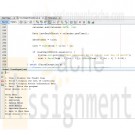
Travel Agents System Java Program
$30.00Travel Agents System Java Program
You are to develop program in Java for a small travel agents. The company arranges holidays from four UK airports to five international destinations. Users need to find flight times and costs for journeys between these destinations. The system also provides information on hotels at the destinations (name of hotel and cost per person per night). Information on hotels can only be added, or loaded from file, when the program is running. The following table (Table 1) provides the airport names, destinations, costs and flight times for the journeys Table 1 Information for the travel agents program – the two values represent cost (£) and flight time (hours) respectively – you can make up your own (realistic values) if you wish
Airport/Destination | New York |Dahab | Rome |Sydney |Tokyo
East Midlands |200/5.0 |150/4.0 |100/1.0 |500/22.0 |400/12.0
Birmingham |190/4.8 |140/3.5 |95/1.1 |480/22.5 |380/12.5
Heathrow |195/4.9 |140/3.6 |95/1.1 |490/23.0 |390/12.5
Manchester |210/5.5 |145/3.7 |110/1.2 |470/22.7 |370/12.6(the above is a data table, where there is a line, represents the cell)
Your program should have a main menu with four options – Time, Price, Hotels and End (which terminates the program). The Hotels option takes the user to another (Hotel) menu with the following six options – View Hotels; Add Hotel; Delete Hotel; Save Hotels; Retrieve Hotels; Exit (back to the previous menu). Note that your program should include appropriate error trapping – for example, entering an invalid date (eg 30 February).
Functionality for each of these menu options is explained below:
Time – Provides the flight time presented in hours.
Price – The cost of travelling from an airport to a given destination (both selected by the user). Note, if the customer is travelling on the last day of the month the fare should be increased by 5% (and display a message to say that this has been done). The system will therefore need to ask the user the date of travel. It should not simply ask the user if it is the end of the month – but work this out from a date provided by the user.
Hotels – Takes the user to a Hotels Information Menu.
Hotels menu
View Hotels – The user selects a destination and the system displays all available hotels at that destination including the overnight cost per person. If there are no hotels for a destination it should display a message to say so.
Add Hotel – Allows the user to add a hotel for a given destination. This should add to the list of existing hotels for that destination (if there are any). For example, I might add 'Belle Vue' as a hotel in Sydney at a cost of £50 per person per night.
Delete Hotel – Allows the user to delete a hotel from a list of hotels at a destination.
Save Hotels – save all the information on all hotels to a single file in a format of your choosing.
Retrieve Hotels – read in all the information on hotels from a user selected file (a file saved using the previous option). This should overwrite any existing hotel data in the program when it is running.Marking
The more functionality you add to the program the higher your mark. Begin by getting the menu options in place then add functionality to your program in the following order (make sure that earlier parts of the system are working properly before moving on). Your program should also be structured in an object oriented way. You should try to identify and implement a number of classes for this program.Minimum pass (40%)
The flight time between any airport and destination;
The cost of travel between any airport and destination;
Increased cost of travel on the last day of the month and a message to say this has been applied;40%-70%
View hotels – users can view information on all hotels at a chosen destination; Add hotel – the ability for users to add hotels for a destination;
Sort hotels – users can sort all hotels alphabetically;Documentation
Learn More
Your coursework should be submitted with appropriate documentation. You should include class diagrams, designs, functionality not completed, functionality working, test plans, evaluation, and program listings. Make sure you include an explanation of how your code should be run (eg. which file should be compiled and run and anything I need to know about using the program – a user guide).




